Posted by Rich Harshaw on June 6, 2017.

I’m dating myself with this story, but oh well.
My oldest son, Sam (24), took driver’s training in 2009.
When the kids in his class would practice driving on the roads, they knew they were supposed to use the turn signal when turning and when changing lanes.
But what about other times?
Did they really have to signal when merging on the highway… or when pulling into a parking spot?
The driving instructor, a no-nonsense kind of guy, always had the same response to the “blinker” question…
“Does it hurt anything? Does it cost anything?”
Point taken.
Now my son still fastidiously signals… pretty much all the time.
Think of this story the next time you ask yourself, “Should I respond to my online reviews?”
Here’s why…
Studies show 92% of people now read online reviews. That makes online reviews one of the most influential aspects of your marketing. Period.
Similarly, most of our clients know they should respond to negative online reviews. It just makes sense: Upset customers need to be dealt with—it’s obvious.
But what about responding to GOOD reviews? Is it really necessary?
“Does it hurt anything? Does it cost anything?”
The truth is, it actually PAYS huge dividends.
Your default position should be to respond to EVERY SINGLE online review.
Yep, all of them.
It’s an easy way to boost SEO. And it can help you drum up more business.
I’ll tell you how in a second.
But first, here is the exact blueprint for responding to good AND bad reviews…
Responding To Good Reviews
- Thank the customer.
- Specifically acknowledge what’s in the review; you want people to know it’s actually you and not an automated response. (“I’m happy to hear [insert employee name] provided a great experience for you.”)
- SEO-ify your response by inserting your company’s name, location, and services. (“At [insert name], we’re proud to be one of [insert location]’s best [insert service].”)
- Market your company. Mention why you were able to provide a great experience. Then, invite your customer to try another of your services and refer their friends.
What Happens When You Respond To Good Reviews:
1) Prospects find you more friendly and caring, so they’re more likely to hire you;
2) your SEO gets a little boost;
3) you get to market your company and showcase your strengths.
Example of responding to a good review:
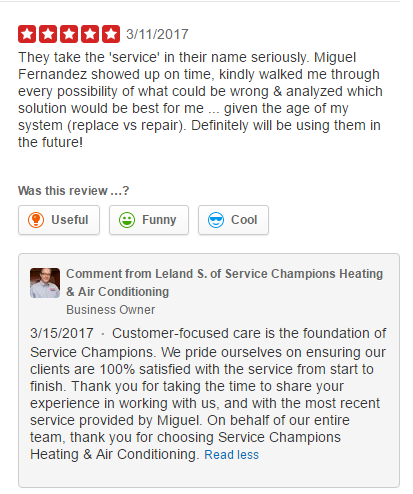
Responding To Bad Reviews
- Say you’re sorry and express sympathy. (“Hi, [Name]. I’m sorry you had a bad experience.”)
- Own up to any mistakes, and explain the type of experience you usually provide. (“We’re known for our attention to detail, and we apologize for missing the mark.”)
- Provide your contact info, so you and the customer can discuss the issue and resolution one on one.
- Keep it concise. No need to go into too much detail and say something that will make your customer more mad.
- Do NOT include SEO stuff like business name, location, and services. It’s best if this review doesn’t show up on Google.
What Happens When You Respond To Bad Reviews: 1) The unsatisfied customer may change their negative review to a positive one; 2) the customer—now happy with you—is more likely to refer you or hire you again; 3) prospects see you fix problems, rather than neglect them, and that peace of mind makes them more likely to hire you.
Example of responding to a bad review:
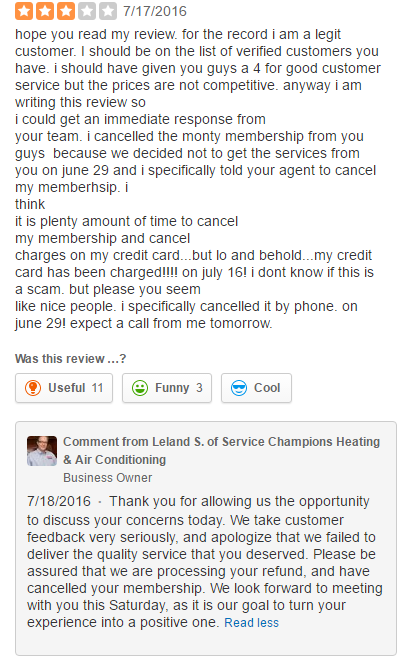
See? Simple.
The company in these examples is Service Champions. Leland, the owner, responds to literally every single review the company gets—good and bad. And they also happen to be the biggest HVAC company in California.
Here’s the thing…
The kids in my son’s drivers training class already knew the answer to the “blinker” question before they asked. They were just being lazy and didn’t want to reach the three inches to flip the turn signal.
The moral of the story: When it comes to responding to online reviews, don’t be like a lazy teenager.
Follow the blueprint I laid out above to squeeze every last drop of marketing juice out of your online reviews.
After all… it doesn’t hurt anything… and it doesn’t cost anything. 😉
Save
Save
Save
Posted by Rich Harshaw on June 6, 2017.

The other day I was reading an article on CBSnews.com called Uh-Oh! 12 Diseases Doctors Overlook.
The article starts by saying, “Some medical conditions are easy to diagnose. Others produce symptoms so vague or “nonspecific” that even skilled doctors have a hard time telling what ails the patient. As a result, some patients spend years or even decades suffering from treatable maladies.”
It then went on to list the diseases, which included sleep apnea, migraines, bipolar disorder, and hip disease.
After reading the list and giving myself a mild case of hypochondria, I thought about a disease the article didn’t list.
It’s more widespread than the common cold. And it’s deadly to those it infects.
But here’s the interesting part…
It doesn’t affect humans.
Or any other living creature, for that matter.
So… you don’t have to worry about yourself, your family, or your pets.
It is, however, likely infecting something VERY near and dear to you RIGHT NOW.
I’m talking about… your website!
I’ll explain.
There is an insidious hidden internet “disease” known as toxic backlinks.
Toxic backlinks poison your search rankings.
They pop up randomly without you realizing it. And they are a constant threat that can’t be “cured” (you can’t “toxic backlink-proof” a website).
They’re like a hard-to-detect disease. You’ll feel the symptoms (drop in SEO). You’ll think it’s for a million and one reasons (wrong keywords, poor content, etc.). But you won’t know what’s causing it unless you get “tested by a professional.”
So… what, exactly, is a toxic backlink?
You know that when website A links to website B, website A creates a backlink for website B. Websites with many reputable backlinks will rank better in Google searches.
But not all backlinks are reputable. Paid links, link wheels, and spam links are what Google calls “toxic” backlinks.
Google considers toxic backlinks “unnatural,” as these backlinks serve no purpose other than to manipulate search rankings.
If Google finds toxic backlinks associated with your website, they’ll penalize you. BIG TIME.
At MYM, we’re very familiar with toxic backlinks; a few weeks ago, we removed 544 of them from our clients’ websites.
When my SEO team told me about this, I said, “Holy cow, that seems like a lot.” Even I wasn’t aware of how widespread a problem toxic backlinks are.
So I asked our SEO Developer (Nate) about the process to learn more, so I could pass the information on to you.
Here is our conversation:
Rich: Why didn’t we find these toxic backlinks sooner?
Nate: This is actually an ongoing process, so it’s not that we didn’t find them sooner, or that we found them too late. We crawl all client backlink profiles weekly with fresh backlink indexes from Google and other various backlink profiling services, so we are constantly keeping an eye on things that will bring client search rankings down.
Rich: How long does it take to remove toxic backlinks?
Nate: It depends on how many different backlinks there are, and also how many domains the backlinks are originating from. We have to manually look through the flagged backlinks and see if they’re actually toxic, and also check on other ranking metrics for the domain that the backlink is coming from, to see if it’s truly toxic or if it’s an actual good backlink. All in all, it’s a few hours each week that go into keeping all of our clients clean and free of toxic backlinks.
Rich: What do we expect the results to be?
Nate: We expect the results will be us continuing to drive our clients’ search rankings higher by negating any ill effects that the toxic backlinks would have on said search rankings. As this isn’t a one-time process and is instead an ongoing thing, there’s no “wow” factor, so to speak, as we keep things copacetic all the time versus running a backlink audit once a year and seeing improved results afterward.
Bottom Line: Removing toxic backlinks is the opposite of sexy. But it’s REQUIRED to maintain your search rankings.
At MYM, we do the flashy, powerful, persuasive marketing. (That’s obvious.)
But we also do the boring, technical behind-the-scenes stuff that keeps everything running smoothly.
After all…
The Mona Lisa hasn’t remained in pristine condition by itself for 500 years. It’s undergone a ton of low-profile maintenance.
It’s the same with your website. To keep it sparkling and shining at the top of the search engines, you have to perform regular upkeep in the background.
Want to know what search results-debilitating “diseases” your website carries?
Sign up for our free Lead Generation Audit.
Part of the audit involves analyzing your SEO efficacy, keyword rankings, and Google Analytics. And yes, that includes toxic backlinks.
Get to it!
P.S. If you’re considering removing toxic backlinks from your website by yourself, here’s my advice: Don’t.
As you can glean from Nate’s responses above, removing toxic backlinks is a technical process. If you don’t know exactly what you’re doing, you’ll likely screw up your search rankings.
The best course of action? As with other specialized trades (remodeling, vehicle repair, etc.): If you want it done right, hire a professional.
Posted by Rich Harshaw on June 6, 2017.
When it comes to ranking on Google, patience is an agonizing virtue.
Even when you do everything right with SEO, it can still take months just to START seeing a positive trend in your rankings.
But if you can endure the long and painful wait, you’ll be richly rewarded.
Case in point…
We recently saw some VERY strong upward ranking trends for our client Zen Windows Des Moines.
Zen Windows Des Moines opened in September 2016. Prior to working with MYM, they had no website. They had only a bio page on the main Zen Windows website and a Facebook account. We had to build their online presence from the ground up.
That makes the rankings I’m about to show you extra impressive.
Between April 24th and May 23rd (our SEO reporting period for the month), almost every one of their keywords improved in ranking. Some jumped as many as 80 to 99 spots!
The most dramatic improvement was for the keyword “casement window Des Moines.” Just a month ago, Zen Windows Des Moines was nowhere to be found on Google for this keyword. Now, they’re…
The 1st ad you see in PPC
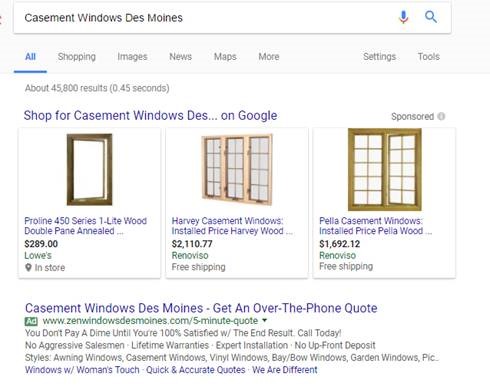
#3 in the Google Local Pack (under the map)
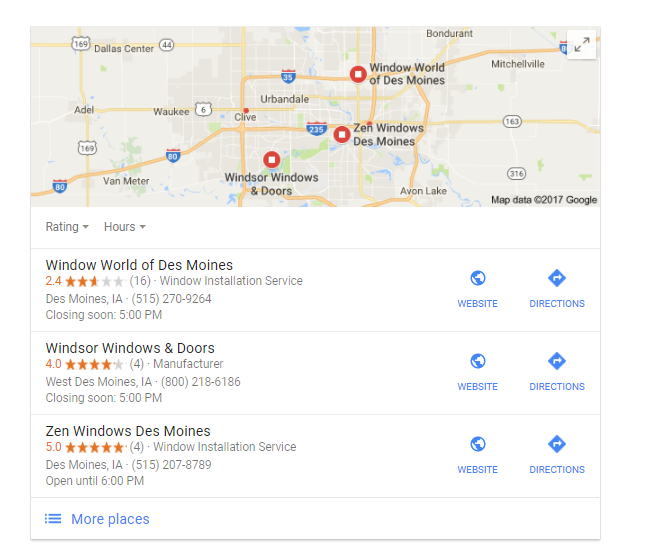
#22 in the organic listings for their blog (yes, the blog!)
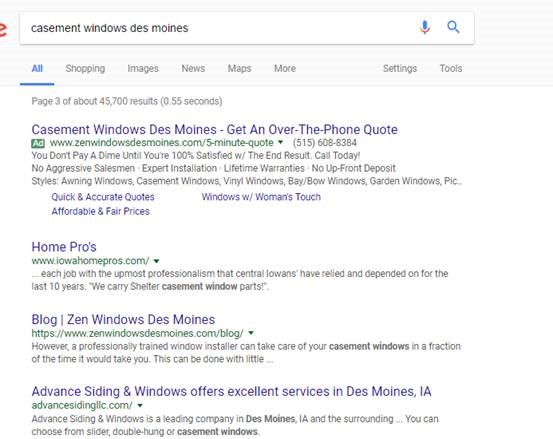
#20 in the organic listings for Super Pages (one of the business listings we manage for clients)
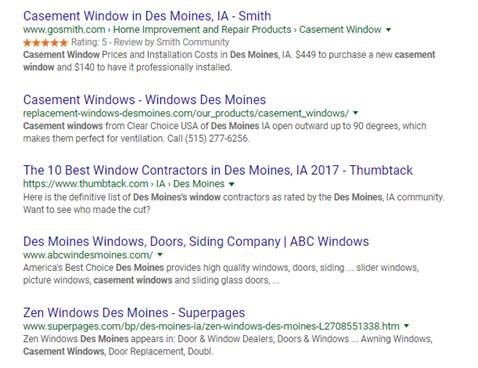
And like I said, it’s not just “casement windows Des Moines” that has improved. Keyword results are up across the board (keywords blurred for client privacy):
The rest of Zen Windows’ sweet rankings: page 1
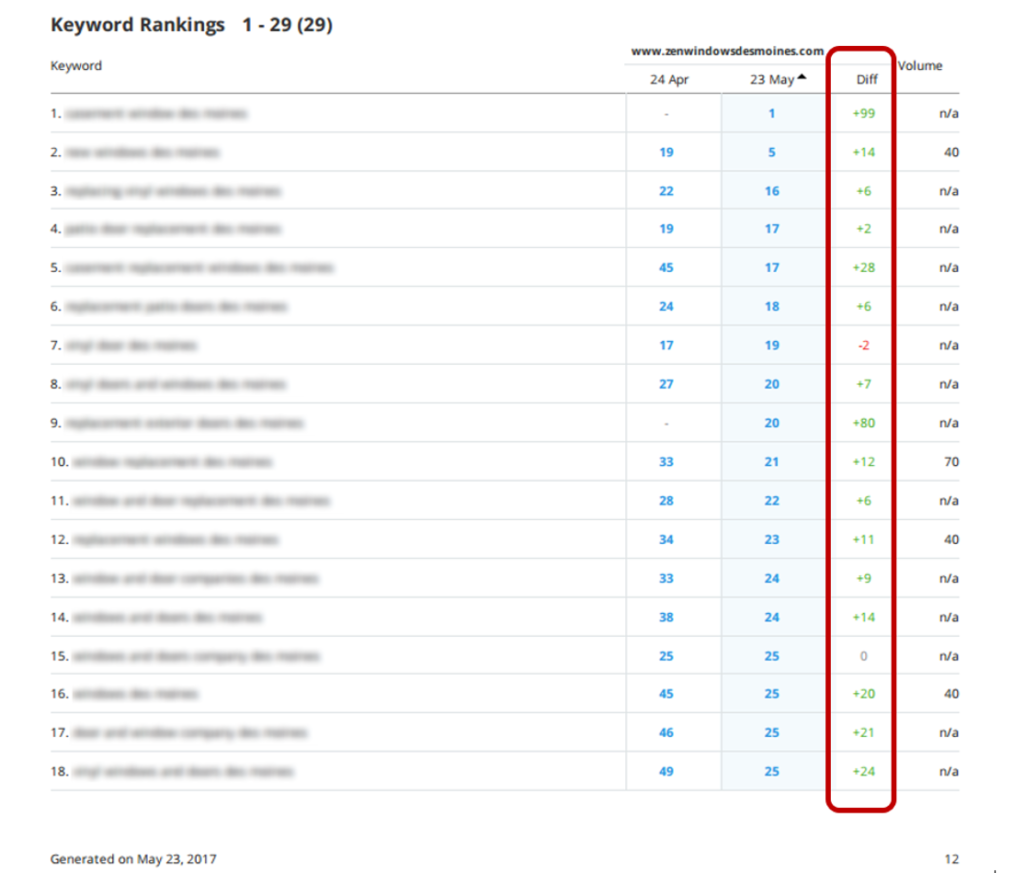
The rest of Zen Windows’ sweet rankings: page 2
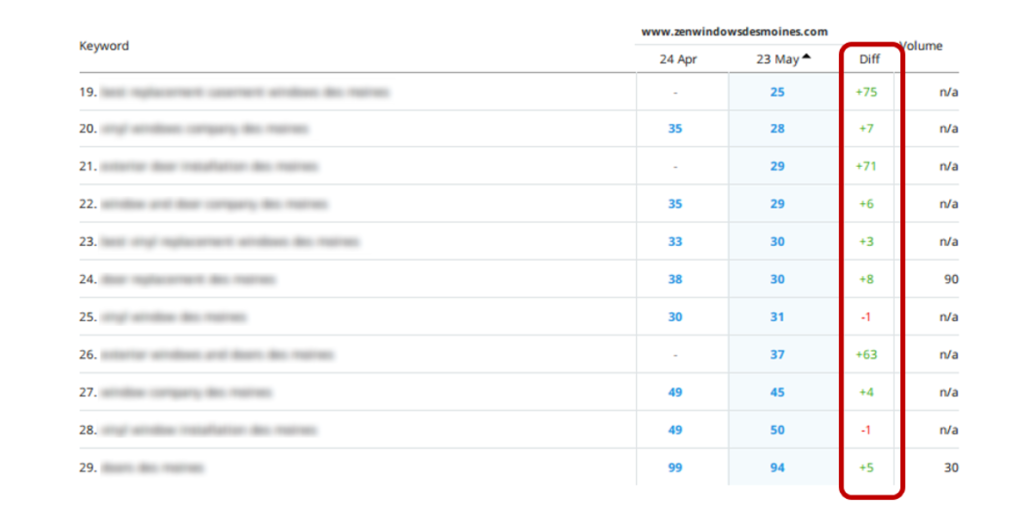
A few takeaways from these rankings if you’re a contractor:
- Your blog is really important for SEO.
- Your business listings are really important for SEO.
- Landing a spot on the Google Local Pack is HUGE for getting leads.
- PPC is a great for “skipping ahead of the line” and claiming real estate at the very top of page one.
- Once your SEO “gains traction” in Google’s rankings—and you remain steadfast in your commitment to the optimization process—you’ll start to experience more and more amazing results every month.
Remember: These rankings for Zen Windows Des Moines are after only three and a half months… and with zero prior SEO “foundation” to work from.
While results vary from client to client, this case study reveals how quickly our clients can gain SEO traction when they begin working with MYM.
I’ll keep you posted on Zen Windows Des Moines’ progress in future emails; there are sure to be bigger and better SEO results in the coming months.
In the meantime, head over to MYM’s SEO page for details about our SEO services and pricing. Also take advantage of our free Lead Generation Audit to see where your website is ranking on Google right now.
P.S. Did you know 92% of consumers read online reviews before contacting a contractor? Next post, I’ll reveal why it’s good business to respond to your online reviews—good AND bad. I’ll even provide the blueprint on EXACTLY what to say.
Save
Posted by Rich Harshaw on June 6, 2017.

Want to know the #1 reason contractors don’t close sales meetings?
Hint: It’s probably not what you’re thinking.
While “no money,” “needed more info,” and “bad timing” are all solid answers, they’re not the most common reason for sales meetings that end… well, without a sale.
Not. Even. Close.
The biggest reason people don’t buy during that initial meeting (which radically reduces the chance they’ll buy at all) is good old-fashioned sticker shock.

Yes, really. I’ll explain.
You are asking people for a lot more money than they were likely expecting you to. Though they may be able to afford it, the collision course of their flowery expectations with a (much) more expensive reality is enough to kill a sale.
Think about it…
Contractors sell a fairly expensive service that people don’t often buy. This means most homeowners don’t have a frame of reference for how much they should expect to pay. And when they don’t know, they tend to underestimate the cost.
So when you show up to sell to prospects, you have to cover a lot of ground to close that gap. This leads to frustratingly long sales cycles, sales meetings that stretch well beyond what they’re supposed to, and the prospect raising phantom objections (because they’re too scared to admit that, holy cow, this is more money than they were expecting!).
Here’s how you prevent sticker shock in your prospects and make closing ratios soar…
-
Utilize Pre-Positioning Materials
One of the best ways to quell sticker shock is to start building a case for the value of your services before you meet with the prospect.
You can do this by sending the prospect Pre-Positioning materials—informative sales materials and reports (printed work best, but PDF documents work in a pinch) that showcase a bit of your Identity while educating them on how to make good decisions for their home and project.
Two examples of Pre-Positioning materials we include provide our clients are the Contractor Standards Guide (a guide that helps homeowners choose the best contractor) and Product Reports (a brochure that provides specific info about a product you sell).
Contractor Standards Guide (Roofing Contractor)
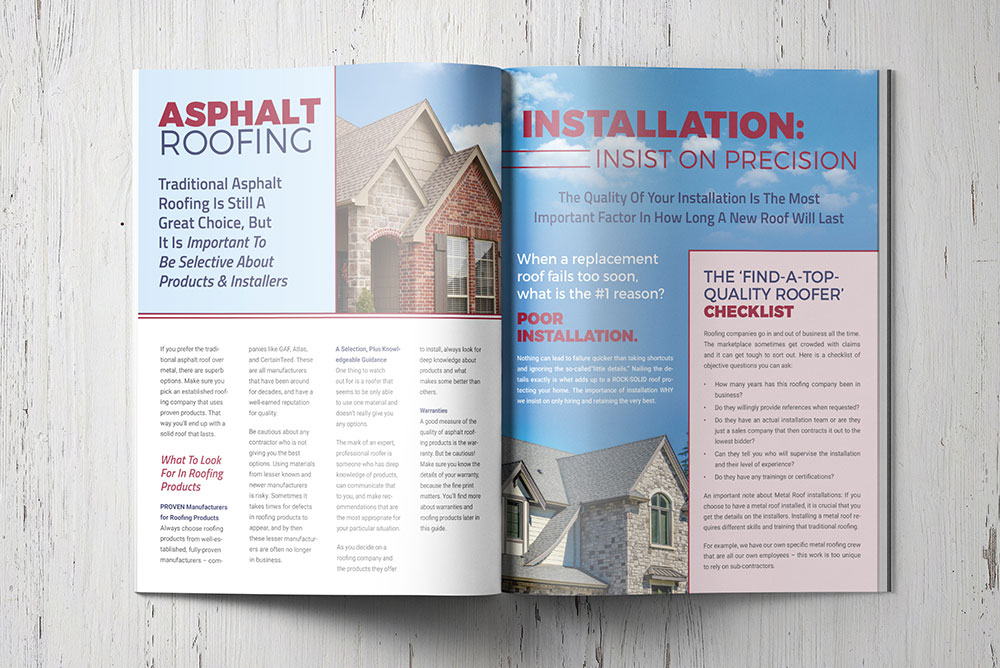
Product Guide (Hardwood Floors)
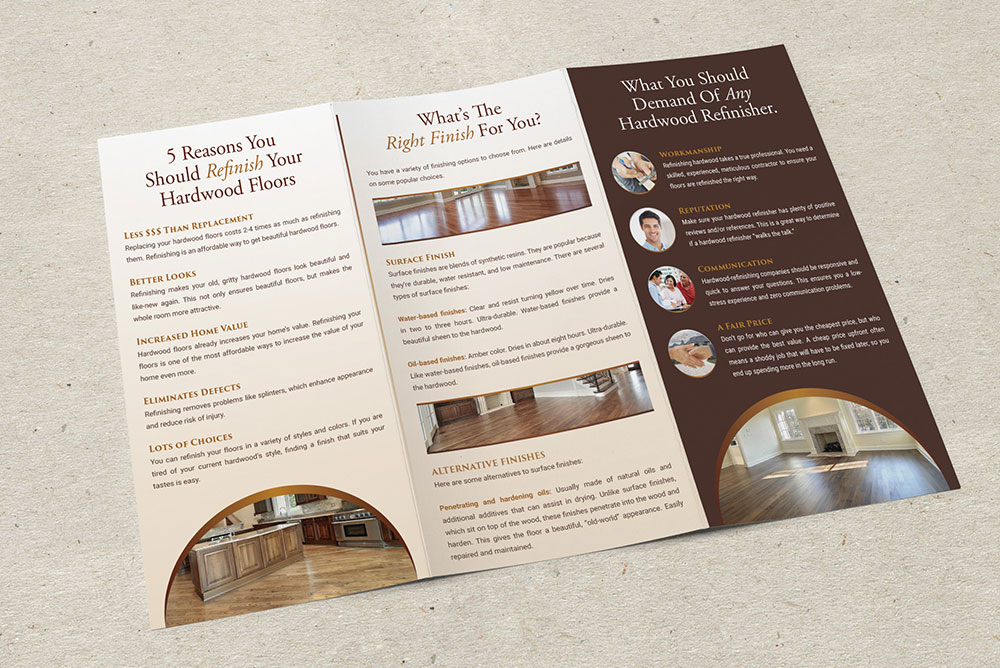
The goal of Pre-Positioning materials is lay out all the main points you’d make during the sales meeting to win them over on price. The key here is that you’re setting expectations BEFORE dropping a price on them. And since it’s in writing—rather than coming from a salesperson’s mouth—it has more credibility and authority.
-
Confirmation Calls
The next step is to make sure your prospect has read the Pre-Positioning materials before your meeting. When you call to confirm the sales appointment, ask the prospect if he’s had to review the materials you sent. Let him know about the important information he’ll find in the report, and direct him to the most relevant parts.
Don’t just say, “Hey, read this because you have the wrong idea about price and I don’t want to battle you on it.” Instead, frame yourself as the prospect’s advocate and tell him that the Pre-Positioning report will educate him on the right questions to ask during your meeting (or any sales meeting, for that matter).
-
Let Prospects Go Price Shopping
If you’re not able to close the deal at the appointment, by all means, let your prospect shop the competition with the Pre-Positioning materials you’ve armed him with. It may seem counterproductive, but if you’re a quality company, you should never be afraid to let an educated prospect shop around.
Besides, he already knows you may cost more than your competitors. And since you gave him the materials he needs to see that low price also means low quality, low service, and low reliability, there is a fantastic chance he’ll come back to YOU.
If you want to increase closing ratios, boost your average sales amount, and eliminate sticker shock in your prospects, click here to learn more about MYM’s Pre-Positioning package.
Save





















